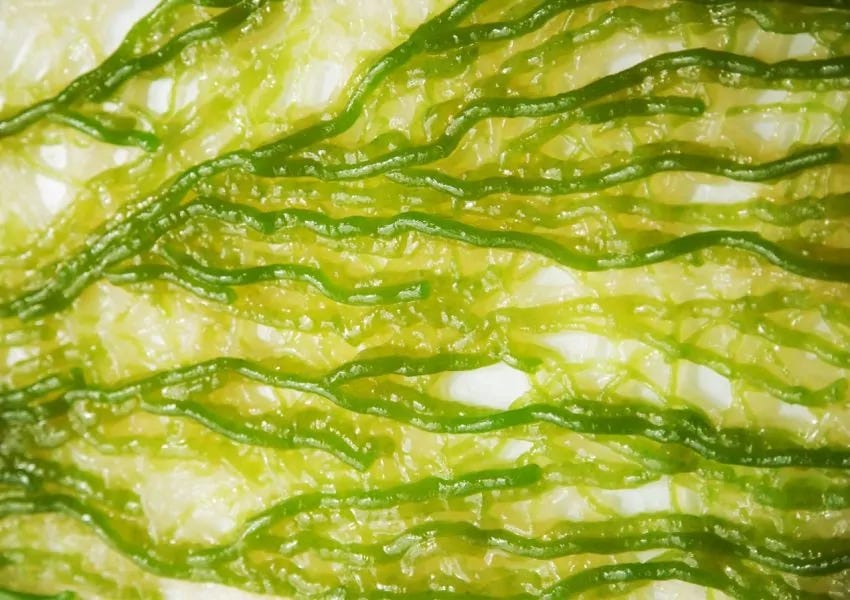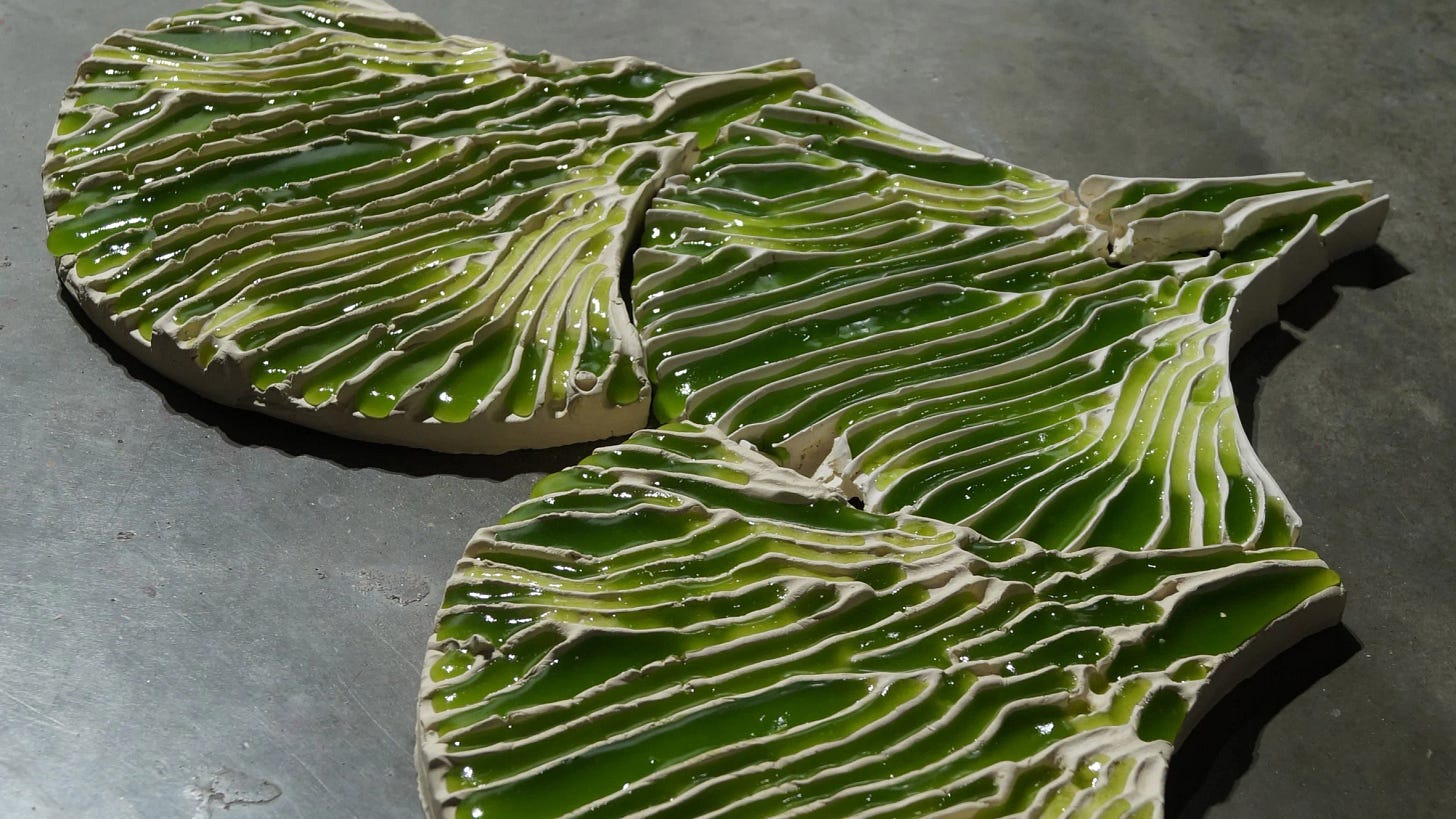Many of the materials in our anthropogenic environments today are derived, directly or indirectly, from living organisms, but they themselves are not alive: they don't breathe, heal, or grow. The passivity and plasticity of these materials are reassuring: they can be easily manipulated to meet our exact needs. In contrast to this dominant paradigm, “living architecture” is a design approach that integrates living organisms into construction materials and artificial structures. The philosophy of living architecture challenges the widespread notion of materials as inert substrates whose sole purpose is to be shaped by human hands. Instead, it fosters a symbiotic relationship between humans and materials, where our interaction with them stops being simply instrumental and becomes increasingly symbiotic.
Although it resembles a natural organism, the green, viscous network you see in the picture above is actually an artificial material; it was fabricated by combining microalgae (Chlorella sorokiniana) with a hydrogel. Hydrogels are slime-like materials capable of retaining large amounts of water within their molecular structure, making them excellent scaffolds for the growth of living cells. The specific hydrogel used in this living material is composed of alginate, a biodegradable polysaccharide derived from seaweed. Polysaccharides - long chains of sugar molecules - form the basis of numerous biomaterials found in nature, ranging from wood to mycelium to insect exoskeletons. Thanks to a 3D printer, this living material can be deposited into any desired structure.
The photosynthetic algae living within the hydrogel capture CO2 from the air and store it in their biomass while producing oxygen, just like trees do - albeit on a much smaller scale. However, microalgae such as C. sorokiniana are also well-known for their ability to absorb toxic heavy metal ions, including arsenic and lead, effectively eliminating them from the environment through a process called biosorption. The researchers involved in developing this material have already utilized it to create a prototype of "living" clay tiles for wastewater treatment in India, where pollution resulting from the textile industry has become an increasingly pressing concern.
Hydrogels - commonly known as “slime” in everyday language - are captivating and versatile materials whose value in both nature and technology often goes unnoticed. A few days ago, I started reading Susanne Wedlich's book, Slime. A Natural History - an extensive essay exploring the importance of slime in different scientific and cultural contexts. Among countless other fascinating things, Wedlich discusses the concept of the “primordial slime”, a vast accumulation of gooey protoplasm that, according to some nineteenth-century scientists, lay hidden on the ocean floor.
Ernst Haeckel (we already encountered him last week as we spoke about diatoms) believed that this speculative substance - which he modestly dubbed Bathybius haeckelii - was the original ancestor of all life on Earth. Despite extensive exploration of seafloors worldwide, however, no evidence of any primordial protoplasm was ever found. Nevertheless, Wedlich cleverly argues that the role of slimy materials in the evolution of life was no less significant. From the specialized hydrogels lining our internal organs to the gelatinous bodies of jellyfish, from ancestral microbial mats to the bacteria inhabiting our digestive tract, slimy substances have played an invaluable part in shaping the development of life on our planet.
Hydrogels owe their remarkable versatility to their characteristic “sliminess”, which is more of a qualitative description than a quantitative one. “Sliminess” is associated with non-Newtonian behavior, meaning that slimes do not conform to the properties of either solids or liquids. In fact, one of the most important things that make slime “slimy” is its hysteresis, that is, its capacity to challenge our conventional understanding of how materials “should” behave across time and space. Slime does not retain its shape completely, nor does it flow freely; rather, it creeps, deforms, drips, and sticks to the surfaces it encounters. Wherever and whenever it goes, it always leaves a trail behind.
In the field of materials science and technology, hydrogels stand out as one of the most promising classes of materials. Their unique ability to serve as a growth medium for life makes them the ideal foundation of many “bio-hybrid” living materials, combining cells and tissues with non-living substances. These materials construct synergistic interactions between nature and technology and question any rigid separation between one and the other. Just as it was once considered the origin of all life, today slime could be regarded as a universal medium for this emerging technological symbiosis.
References
Malik, S., Hagopian, J., Mohite, S., Lintong, C., Stoffels, L., Giannakopoulos, S., Beckett, R., Leung, C., Ruiz, J., Cruz, M., Parker, B., Robotic Extrusion of Algae-Laden Hydrogels for Large-Scale Applications. Global Challenges 2020, 4, 1900064.
Susanne Wedlich, Slime. A Natural History, Melville House, New York and London, 2022 (Italian ed. Susanne Wedlich, Vischioso. Storia naturale dello slime, Nottetempo, Milano, 2023)





![[animate output image] [animate output image]](https://substackcdn.com/image/fetch/$s_!V0aG!,w_1456,c_limit,f_auto,q_auto:good,fl_lossy/https%3A%2F%2Fsubstack-post-media.s3.amazonaws.com%2Fpublic%2Fimages%2Fabb4e127-2d35-47fc-a564-775b546cf401_600x338.gif)
